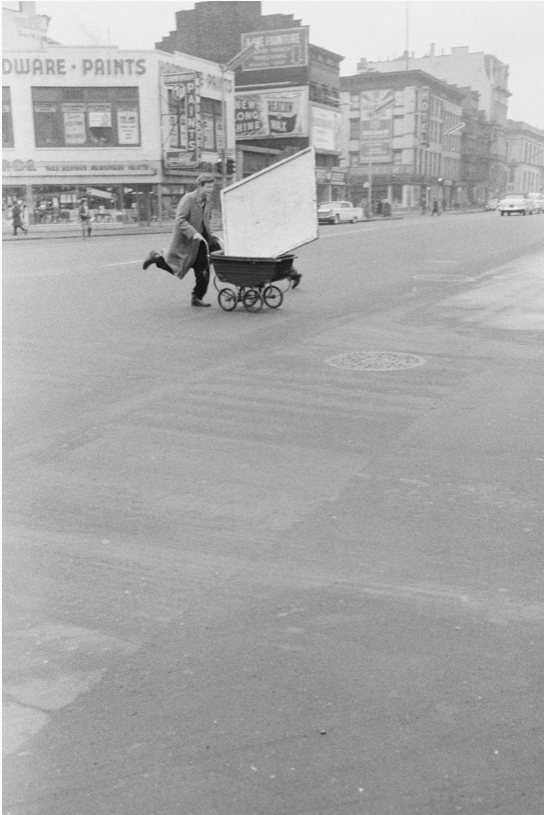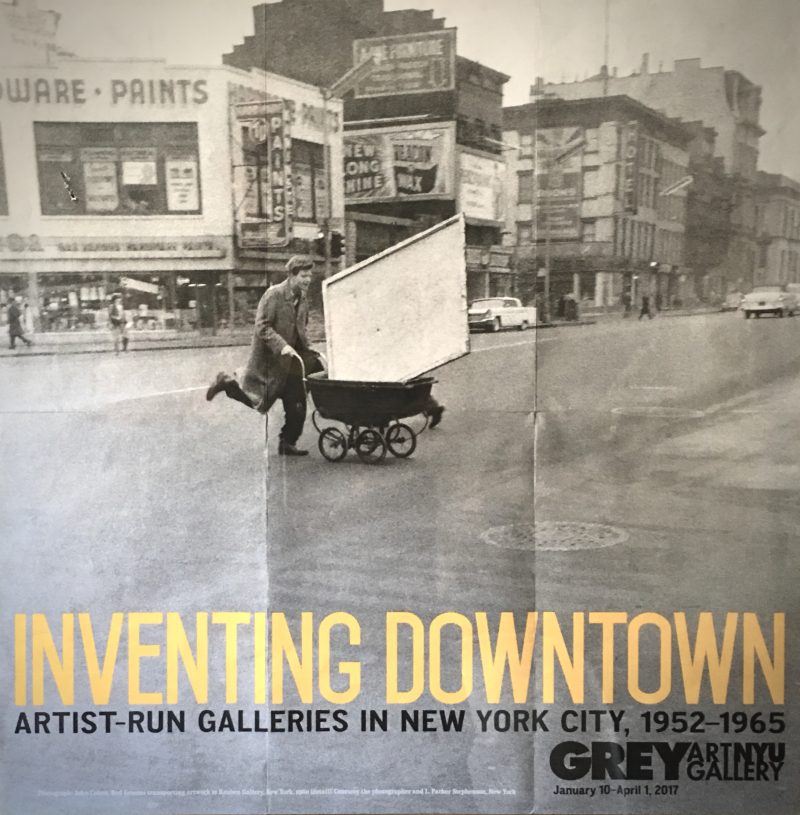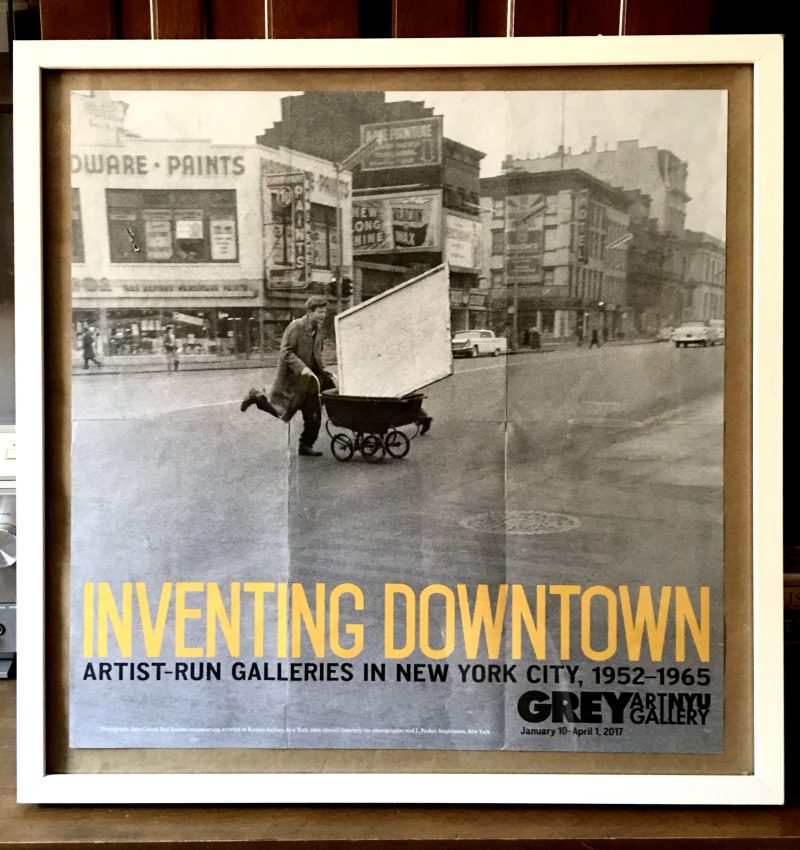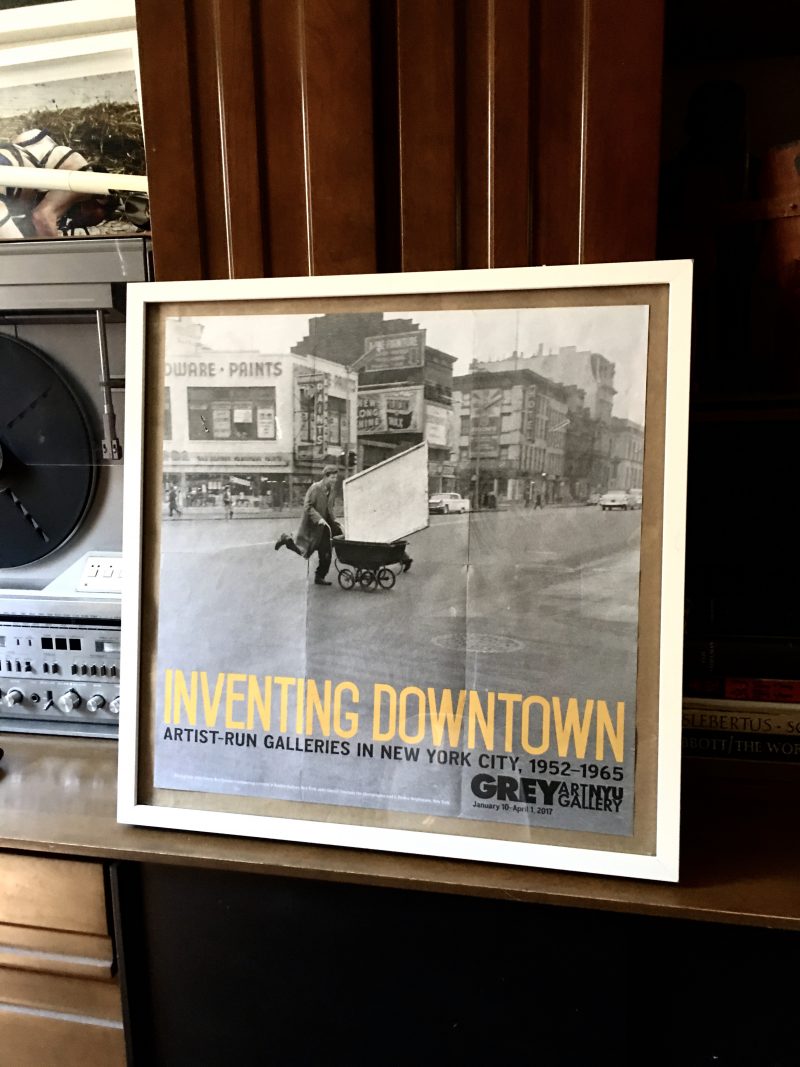INVENTING DOWNTOWN, Artist-Run Galleries in New York City, 1952–1965
Grey Gallery, New York, Original gallery invitation flyer. Measures 17.5 x 18 inches. Folds from 6 panels. Good Condition. Measures 6 x 9 inches when folded as a gallery invitation flyer.
Asking USD$125. (Frame cannot be included when shipping required)
INVENTING DOWNTOWN
Between the apex of Abstract Expressionism and the rise of Pop Art and Minimalism, the New York art scene was transformed by artist-run galleries. Inventing Downtown presents works from fourteen of these crucibles of experimentation, highlighting artists’ efforts to create new exhibition venues for innovative works of art—ranging from abstract and figurative painting, assemblage, sculpture, and works on paper to groundbreaking installations and performances.
Inventing Downtown proposes viewing these fourteen galleries via five thematic groupings. Leaving Midtown focuses on three Tenth Street galleries which adopted a cooperative business structure where expenses were shared among elected members: Tanager Gallery, Hansa Gallery, and Brata Gallery. City as Muse features four ventures that did not adopt the co-op model: City Gallery, Reuben Gallery, Delancey Street Museum, and Judson Gallery. They are best known for creating dynamic installations and pioneering performances. Space and Time investigates two significant artist-run projects, 112 Chambers Street and 79 Park Place, which occupied different conceptual terrains, embraced a wide range of media, and shared an interest in exploring temporality and geo-spatial dimensions. Politics as Practice includes four groups: March Group, Judson Church’s Hall of Issues, The Center, and Spiral Group, which examined the viability of politics as a subject for art and channeled a new sense of social urgency in addressing Cold War politics, the civil rights movement, and the legacy of World War II, among other concerns. Finally, Defining Downtown looks at the Green Gallery, which played a decisive role in bringing downtown uptown and fostering the rise of Pop and Minimalism. Its program, however, resulted in the narrowing of aesthetic possibilities and the marginalization of many artists.
Artist-run galleries shaped American art irreversibly. After 1965, New York’s uptown and downtown art scenes increasingly diverged, which led to the flowering of nonprofit downtown alternative spaces. Although more than half a century has passed since the era of Inventing Downtown, many of the issues mined in the exhibition still resonate in today’s art world—split as it is between the booming commercial market for contemporary art and ever more pluralistic models of artistic production, promotion, and display.
Inventing Downtown is curated by Melissa Rachleff, clinical associate professor in NYU’s Steinhardt School.
Image Credit: John Cohen, Red Grooms transporting artwork to Reuben Gallery, New York, 1960. Gelatin silver print, 10 x 6 3/4 in. © John Cohen.
MORE:
LANDMARK EXHIBITION EXAMINES TRANSFORMATIVE ERA IN NEW YORK CITY ART SCENE
Inventing Downtown:
Artist-Run Galleries in New York City, 1952–1965
On view at NYU’s Grey Art Gallery January 10–April 1, 2017
What happens when artists organize their own exhibitions? This is one of the key questions posed by Inventing Downtown: Artist-Run Galleries in New York City, 1952–1965, a major exhibition that examines the New York art scene during the fertile years between the apex of Abstract Expressionism and the rise of Pop Art and Minimalism. This is the first show ever to survey this vital period from the vantage point of its artist-run galleries—crucibles of experimentation and innovation that radically changed the art world. Organized by Grey Art Gallery at New York University and curated by Melissa Rachleff, clinical associate professor at NYU Steinhardt, the exhibition includes work by artists ranging from such well known figures as Mark di Suvero, Jim Dine, Red Grooms, Allan Kaprow, Alex Katz, Yayoi Kusama, Claes Oldenburg, and Yoko Ono to artists who deserve to be better known, such as Ed Clark, Emilio Cruz, Lois Dodd, Rosalyn Drexler, Sally Hazelet Drummond, Jean Follett, Lester Johnson, Boris Lurie, Jan Müller, and Aldo Tambellini.
On view from January 10 through April 1, 2017, Inventing Downtown features works by abstract and figurative painters and sculptors, as well as those who ventured into installation and performance art. In so doing, it reveals a scene that was much more diverse than has previously been acknowledged. As Rachleff observes, “Some of the most critical innovations of the postmodern era emerged from this in-between, and largely forgotten, period in postwar American art history.”
Grey Art Gallery director Lynn Gumpert adds, “Inventing Downtown brings under-recognized but crucially important artists—especially women and people of color—to the forefront of the history of 20th-century American art, where they belong. We are so pleased to exhibit these works, including a number from the New York University art collection, and many that were created in the neighborhoods that surround the Grey Art Gallery.”
On May 21, 1951, the artist-organized Ninth Street Show, a groundbreaking exhibition featuring works by more than sixty established and emerging artists, opened in a storefront on 60 East Ninth Street, in the East Village. Organized by members of The Club, the highly influential association founded by New York School artists, the exhibition received a great deal of publicity, drawing collectors downtown and bringing attention to the model of an artist-organized show—a way for artists to take their careers into their own hands. Thus began a series of artist-run galleries that would dramatically expand the boundaries of what art could be.
With more than 200 paintings, sculptures, installations, drawings, photographs, films, and ephemera, Inventing Downtown looks at fourteen artist-run galleries and their role in the creation and presentation of new art. The exhibition opens with a focus on the Tanager, Hansa, and Brata Galleries, co-op galleries that opened on or near East Tenth Street between 1952 and 1957. Each of these artist-run galleries had a distinct vision, and together they helped to redefine the parameters of art-making, challenging the very definition of art as pronounced by critics and museum curators.
Tanager (May 1952–June 1962) was unique among co-op galleries in its refusal to focus on a single aesthetic ideology. Taking an inclusive view of various artistic tendencies, the gallery, which was managed by then-graduate-student Irving Sandler, regularly presented works by non-members alongside that of member artists. Inventing Downtown looks at this broad perspective through the lens of The Private Myth, an ambitious exhibition mounted at the Tanager in October 1961. Curated by Philip Pearlstein and Sidney Geist, the show included works by artists as varied as Louise Bourgeois, Charles Cajori, and Mary Frank, whose nearly abstract wood sculpture of a reclining figure is on view. Alex Katz’s majestic double portrait Ada Ada (1959), one of the highlights of NYU’s collection, is also among the artworks by key Tanager members included in the exhibition.
The artists associated with Hansa Gallery (November 1952–June 1959) worked to move beyond abstraction to incorporate the materials of everyday life into their art. Inventing Downtown opens a window onto these radical efforts with rarely seen artworks by gallery members such as Allan Kaprow, whose 1958 environments, in which the gallery itself became an object with every corner filled with materials, smells, and recorded sound from the street, are represented by photographs taken by his then-wife, Vaughan Kaprow. This section also calls attention to a number of Hansa artists—many of them women—who have been overlooked. Jean Follett, for example, is represented by Many-Headed Creature (1958), an assemblage including a light switch, window screen, mirror, twine, and other traditionally non-art materials. A rare woodblock print announcement designed by Wolf Kahn for the 1955 Xmas Show of Small Works of Art, a draft of the Hansa bylaws, and other ephemera convey the Hansa artists’ creative energy and innovative ideas.
Brata Gallery (October 1957–April 1962) owed its influence to a core group of artists, led by Nicholas Krushenick and Al Held, both of whom distanced their work from the emotive gestures of Abstract Expressionism in favor of an analytical approach to shape and form, thereby pushing abstraction into radically new terrain. The gallery is also notable as one of the few to include artists of color in its roster, including Ed Clark, one of the first African Americans to show on East Tenth Street, as well as numerous Japanese artists. Inventing Downtown represents this co-op space with work by Ronald Bladen, Clark, Held, Krushenick, Yayoi Kusama (whose first show was at Brata, thanks to Clark), Nanae Momiyama, Sal Romano, and George Sugarman.
Not all of the galleries in the show were based on the co-op model of shared expenses and management, and not all were on Tenth Street. As galleries opened in other areas downtown, they transitioned to informally-financed and run exhibition spaces. Red Grooms, Claes Oldenburg, and Allan Kaprow—all of whom drew both inspiration and materials from New York City—played a central role in the creation and rapid growth of these often short-lived spaces, which were conceived as part studio, part gallery, part laboratory.
City Gallery (November 1958–May 1959), located in Red Grooms’s studio on Sixth Avenue at West Twenty-fourth Street, was the first artist-run space to operate without bylaws. Its less restrictive, more intuitive approach is clearly evident in the group show Drawings (1958–59), for which curator Michaela Weisselberg selected works by 45 artists who would not otherwise have shared the same space, among them Franz Kline, Georg Grosz, Milton Resnick, Grooms, Claes Oldenburg, and Philip Guston. Inventing Downtown displays 23 works from this show, including Grooms’s exuberant ink drawing Untitled (Street scene with monster) (c.1958), a selection of vastly different street scenes by Mimi Gross, Lester Johnson, and Sari Dienes, as well as the exhibition announcement designed by Grooms and Andersen.
Another gallery to leave the co-op model behind was the Reuben Gallery (October 1959–April 1961), on Fourth Avenue between East Ninth and Tenth Streets. With artists who were making unprecedented shifts away from traditional artistic categories, the Reuben functioned as a midwife to the birth of performance and happenings. The intensity of its efforts is evident in its first season, which presented ten solo exhibitions, two group shows, and three performance series. Allan Kaprow’s iconic, multi-discipline, multi-medium 18 Happenings in 6 Parts (1959)— the score for which is on view—and Claes Oldenburg’s The Street (1960), which summoned the grit and life of the Lower East Side through audacious sculptures made of cardboard, burlap, and newspaper, were among the era-defining works specifically created for the gallery’s space. Other artists included Jim Dine, who had a one-person show; Renée Rubin, whose Coney Island Pinball (1958), made of aluminum and oil on canvas and wood, is on view; Martha Edelheit, represented by her multi-media painting Frabjous Day (1959); and Rosalyn Drexler, whose one-person show included works made of found objects, plaster, and melted lead. Kaprow, who was proving to be something of an impresario, also invited a number of artists, including fellow New Jersey-ites George Segal, Lucas Samaras, and Robert Whitman, to present their work in the space. Inventing Downtown conveys the spirit and work of the Reuben Gallery with artworks, photographs, announcements, and other documentation.
In 1959, Red Grooms moved to an abandoned boxing gym on the third floor of 148 Delancey Street, which he dubbed the Delancey Street Museum (October 1959–May 1960) and used as both a private studio and public gallery. The space’s emphasis was on solo shows, and both Bob Thompson and Marcia Marcus had influential exhibitions at the space. Grooms also staged his signature performance, The Burning Building (1959), there, represented in the exhibition by a slideshow of photos by John Cohen.
Founded by Marcus Ratliff, Tom Wesselmann, and Jim Dine, Judson Gallery (February 1959– January 1962) was in the basement of a student dormitory (with ties to the nearby Judson Memorial Church) on Thompson Street. Claes Oldenburg helped manage the gallery, and in the winter of 1960 he and Dine created what would become a legendary work, an immersive environment comprising the first iteration of Oldenburg’s The Street (1960) and a new work by Dine called The House (1960), a phone-booth-sized house made from leftover theatrical backdrops that Dine found in the church and covered with an exuberance of found materials, drawings, and words. From 1960 to 1962, Kaprow served as the Judson’s curator, developing programming that further advanced assemblage art. As seen here in Dan Flavin’s Apollinaire wounded (to Ward Jackson) (1959–60) and Wesselmann’s Portrait Collage #13 (1959), along with announcements and other ephemera, both Oldenburg and Kaprow were committed to showing young artists whose work was not easily categorized.
Two other artist-run spaces, 112 Chambers Street and 79 Park Place, fostered and exhibited works that incorporated time, audience participation, and physical actions. The artists associated with these galleries were largely West Coast transplants who drew on the revolutionary music of John Cage and on the Bay Area’s radical reinvention of poetry and dance to develop a new approach to visual art to be presented in a new kind of cultural space.
Yoko Ono’s loft at 112 Chambers Street (December 1960–June 1961) was at once a performance venue and her painting studio. In the fall of 1960, composer La Monte Young, who had recently met Ono, invited a group of innovative composers, as well as dancer Simone Forti and artist Robert Morris, to perform in what has become known as the Chambers Street Loft Series. At the same time, Ono was making her groundbreaking action-based paintings. Created by viewers who followed a set of instructions, these works clearly foreshadowed what would come to be called Conceptual Art. While Ono’s work is not often considered in relation to that of Forti or Morris, the former’s instruction-based dances and the latter’s appeal to spectator involvement are important concurrent developments. Inventing Downtown illuminates the short- lived but vital 112 Chambers Street space with photographs, an announcement, and other ephemera.
Space was central to the work of the artists who lived and worked at 79 Park Place (November 1963–March 1964). Co-founded by sculptor Mark di Suvero and other Bay Area transplants, Park Place operated as a collective where artists explored space-time in a variety of ways and used the loft as a workshop in which to test ideas and challenge one another. As artist Dean Fleming recalled, “You would get up there, and it was quiet … and it was completely full of all different kinds of art.” Yet while the artwork created there was diverse, the artists were united in their rejection of the art market and commercial concerns and in their embrace of the community-gallery concept. The work of the Park Place Group is illuminated in the exhibition through sculptures by di Suvero and Forrest Myers; photography, including a never-before- displayed image of 79 Park Place from Danny Lyon’s series The Destruction of Lower Manhattan (1967); and geometric paintings and collages by Leo Valledor, Fleming, and Tamara Melcher.
In the early 1960s, the bright line between art and political activism that had characterized the 1950s began to fade, as artists increasingly began to engage with sociopolitical issues. One of the first galleries to evince this new activism was the March Group (1960–62), an anti-market, politically provocative artists’ workshop founded when artists Boris Lurie and Sam Goodman assumed possession of the March Gallery on Tenth Street. Working with poet Stanley Fisher, they organized three exhibitions: the Vulgar Show (November 1960), which announced the March Group’s intolerance for the business of art; the Involvement Show (April 1961), which mounted a wholesale condemnation of the perceived hypocrisies in American foreign policy; and the Doom Show (November 1961), which critiqued nuclear deterrence policies of the Kennedy administration. The Doom Show displayed toys that had been burned and mutilated to summon the aftermath of a nuclear bomb explosion, as well as agitprop phrases spray-painted onto canvas. Inventing Downtown evokes the group and its exhibitions through artworks including Lurie’s painting Adieu Amerique (1959–60), Fisher’s collage Untitled (Help) (1959–64), posters, and documentary photographs.
The Hall of Issues (December 1961–January 1963) was just that: a corridor in which submissions from “anyone who has any statement to make about any social, political, or esthetic concern” were displayed on wall panels. Organized by artist Phyllis Yampolsky and sponsored by the progressive Judson Memorial Church on Washington Square South, the Hall of Issues changed its displays every Sunday and devoted Wednesday evenings to panel discussions with artists, community activists, and experts in a variety of fields. Artist contributors to the democratic space included Claes Oldenburg, Sam Goodman, Stanley Fisher, and Jean- Jacques Lebel. The spirit and activities of the Hall are conveyed in Inventing Downtown through photographs by Dave Heath and Stanley Schapiro, announcements created by Yampolsky, and a poster by sculptor and performer Peter Schumann, who would go on to found the Bread and Puppet Theater.
In 1962, artist Aldo Tambellini and his then-wife Elsa formed The Center (1962–65), an artist- run organization perhaps best described by Tambellini, who wanted the project “to not be a gallery, but to bring our creations directly to the neighborhood, to be part of the neighborhood.” St. Mark’s Church-in-the Bowery took an interest in The Center and collaborated with it, also arranging a partnership with the Lower East Side Neighborhood Association (LENA), a local social service organization. The first programs produced by “The Center at St. Mark’s Church” were a small exhibition of paintings and a two-week “LENA Festival,” with jazz concerts, poetry readings, and film screenings. Inventing Downtown displays works by Tambellini, including the work on paper We Are the Primitives of a New Era (c.1961), as well as a sculpture, announcements, and a manifesto by the artist.
The first artists to explicitly align themselves with the civil rights movement were a coalition of some fifteen African American men and women who formed the Spiral Group (1963–65). At a time when it was commonly thought that using race as a subject identified a work as sociological rather than aesthetic, many wondered if artists, especially African American artists, could remain dispassionate in the face of the brutal events of the early ’60s. But would they place themselves at a disadvantage in the art world if they identified themselves and their work with race? Such were the concerns at the heart of the Spiral Group, whose only exhibition, the
Inventing Downtown concludes with a look at the Green Gallery (October 1960–June 1965)—a hybrid commercial gallery/artist space directed by Richard Bellamy and secretly financed by Robert Scull. As seen in the artworks and photographs on view here, the gallery introduced new downtown art styles into the midtown art market, helping to solidify the notion of Pop Art through solo shows of such artists as Claes Oldenburg, James Rosenquist, George Segal, and Tom Wesselmann, and establishing Minimalism as a new direction for Donald Judd, Dan Flavin, and Robert Morris. In focusing on a narrow swath of art and artists, the Green Gallery’s program ultimately reduced the scope of aesthetic possibilities and marginalized many, notably women. As a result, uptown and downtown values diverged, leading to a new chapter: the flowering of a second wave of anti-commercial, downtown alternative spaces in the late 1960s and 1970s.
Exhibition Catalogue
Inventing Downtown will be accompanied by a four-color, lavishly illustrated 296-page book with a bibliography and index. Authored by Rachleff, it is published by the Grey Art Gallery, New York University, and DelMonico Books, an imprint of Prestel. Atypical of publications that have dealt with the 13-year period in question, Inventing Downtown shifts the discussion away from a progression of styles—Abstract Expressionism, figuration, Pop, and Minimalism—to a reexamination of the New York art scene from cultural, social, and economic viewpoints. In addition, the book sheds new light on works by women and artists of color, and features never- before-published excerpts from artist interviews conducted by Julie Martin and Billy Klüver.
Sponsorship
Inventing Downtown is made possible in part by the generous support of the Terra Foundation for American Art; the Henry Luce Foundation; The Andy Warhol Foundation for the Visual Arts; the S. & J. Lurje Memorial Foundation; the National Endowment for the Arts; the Boris Lurie Art Foundation; the Helen Frankenthaler Foundation; the Art Dealers Association Foundation; Ann Hatch; the Oded Halahmy Foundation for the Arts; Arne and Milly Glimcher; The Cowles Charitable Trust; and the Japan Foundation. The publication is supported by a grant from Furthermore: a program of the J.M. Kaplan Fund. Additional support is provided by the Grey Art Gallery’s Director’s Circle, Inter/National Council, and Friends; and the Abby Weed Grey Trust.
About the Grey Art Gallery
The Grey Art Gallery is New York University’s fine arts museum, located on historic Washington Square Park in New York City’s Greenwich Village. It offers the NYU community and the general public a dynamic roster of engaging and thought-provoking exhibitions, all of them enriched by public programs. With its emphasis on experimentation and interpretation, and its focus on studying art in its historical, cultural, and social contexts, the Grey serves as a museum-laboratory for the exploration of art’s environments.
Exhibitions organized by the Grey have encompassed all the visual arts: painting, sculpture, drawing and printmaking, photography, architecture and decorative arts, video, film, and performance. In addition to producing its own exhibitions, which often travel to other venues in the United States and abroad, the Gallery hosts traveling shows that might otherwise not be seen in New York and produces scholarly publications that are distributed worldwide.
NEW YORK TIMES review:





